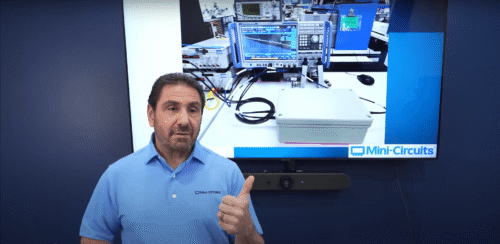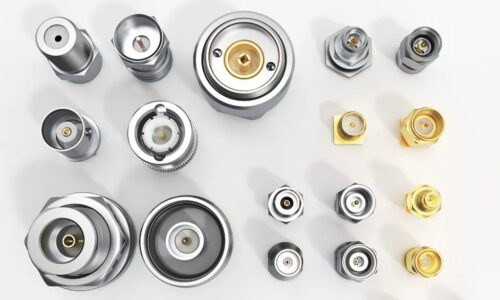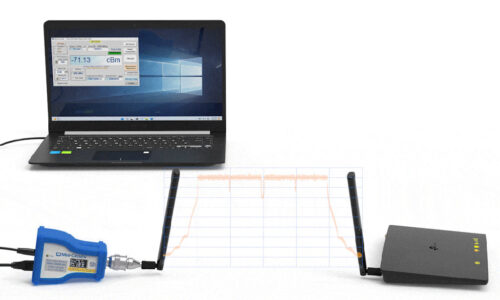Every Block Covered: Cascaded P1dB and IP3 in a 26 GHz 5G Front-End
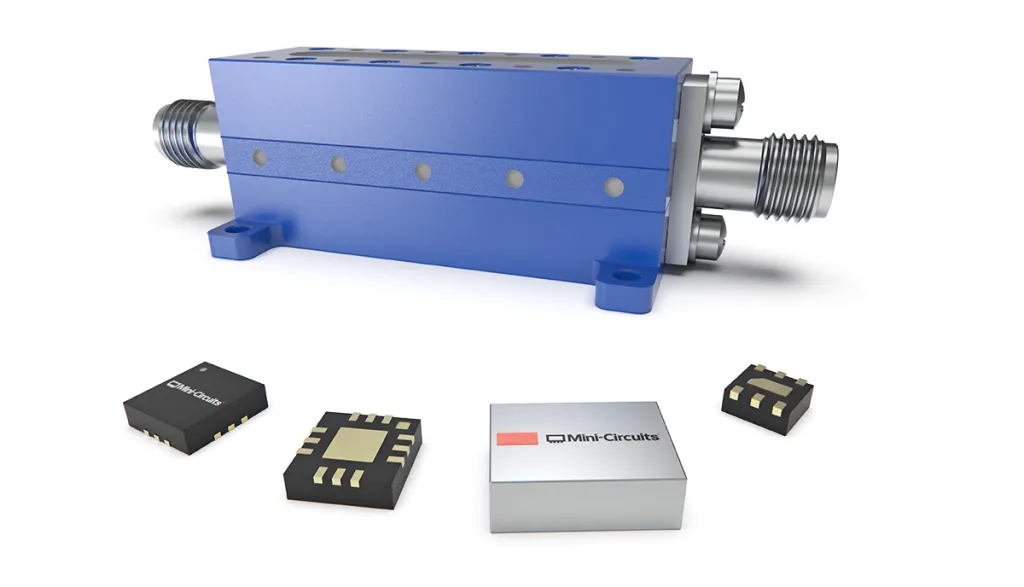
The predecessor to this article reviewed cascade analysis for P1dB and IP3 in a simple, three-component receiver front-end. In that example, the LNA was the only non-linear component in the system, significantly simplifying calculations for linearity parameters. The purpose of this article is to expound on those concepts by analyzing a six-component, 5G RF front end with three nonlinear devices. The computations required to determine P1dB and IP3 when incorporating multiple nonlinear devices into the cascade become significantly more complicated but shed more light on the behavior of linearity parameters at the system level.
Again, the equations we’ll use here do not account for VSWR and impedance mismatch between stages, but barring the adoption of expensive simulation software, they provide a reasonably accurate approximation for the system designer to work from off the cuff.
The System: A 5G n258 Band RF Front End
An RF front end capable of covering the 24.25 to 25.1 GHz portion of the 5G n258 frequency band is shown in Figure 1. For more background on the use of this band in Australian 5G networks, refer to our article discussing Noise and SNR in the same system. This design includes an aggressive preselector followed by a cost-effective, high-performance MMIC LNA. The 3 dB attenuator mitigates any VSWR interactions that may otherwise occur between the LNA and the mixer. The mixer itself is capable of LO/RF operation from 10 to 40 GHz. In this application, the mixer is operated from a 20 GHz LO at +15 dBm, placing the IF band in the 4.25 to 5.1 GHz frequency range. The IF filter is a tiny, ultra-high rejection LTCC filter with a 3 dB BW of approximately 1200 MHz. The IF amplifier is the high-gain, high- linearity MMIC which easily covers the 4.25 to 5.1 GHz IF operating band.
The salient features of each of the six components in the block diagram are given below:
- Preselector (ZVBP-25875-K+ cavity filter): 24.25 – 27.5 GHz bandwidth, 1.72 dB insertion loss at 24.25 GHz
- LNA (PMA3-34GLN+): 21.65 dB gain, 22.93 dBm OIP3, and 11.19 dBm OP1dB at 25 GHz
- Attenuator (QAT-3+): 3.15 dB insertion loss at 25 GHz
- Mixer (MDB-44H+): 10.4 dB conversion loss for RF = 25 GHz, LO = 20 GHz, 20 dBm IIP3 and 10 dBm IP1dB at LO = 20 GHz and +15 dBm
- IF filter (BFHK-4951+): 2.65 dB insertion loss (5.1 GHz), 3 dB BW approximately 4.1 – 5.3 GHz
- IF amplifier (PMA3-83LNW+): 20.56 dB Gain, 28.45 dBm OIP3 and 18.79 dBm OP1dB at 5 GHz

Note that for amplifiers, P1dB and IP3 are typically referenced to the output, whereas for mixers, P1dB and IP3 are typically referenced to the input. For this application note, we will first focus on computing output P1dB (OP1dB) and output IP3 (OIP3) of the RF front end, then show how one can back into IP1dB and IIP3. Transitioning between input and output linearity parameters through the gain of the system or individual device, as in the case of the mixer, will become apparent.
Quick Review: P1dB and IP3
Referring to Figure 2, recall that a linear gain response curve and a third order (cubic) intermodulation distortion (IMD) response will intersect at a purely theoretical third order intercept point (IP3). OIP3 is determined graphically by the projection of IP3 onto the Y-axis (Pout), and IIP3 by the projection of IP3 onto the X-axis (Pin). The solid curves, which represent the operating characteristics of the amplifier or system, tend to exhibit compression as they approach the system’s operating output power limit, and saturation once that limit is reached. Figure 2 also shows the point at which the gain has compressed by 1 dB, which is projected as OP1dB on the Y-axis and IP1dB on the X-axis.
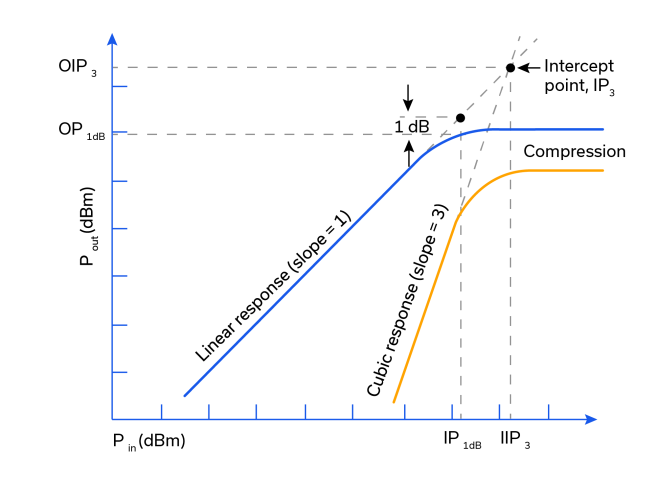
P1dB and IP3 are reflected about the linear portion of the gain curve, and are consequently related by the cascaded system gain. As shown our introductory article on this topic, OP1dB is converted to IP1dB using the equation:
IP1dB = OP1dB – (Gain – 1)
where “Gain” is the cascaded gain through any given (nth) stage in the cascade. OIP3 is referenced back to the input by simply subtracting the cascaded gain:
IIP3 = OIP3 – Gain.
Individual Device Linearity Parameters
These equations become immediately useful for the MDB-44H+ mixer in the system shown in Figure 1. For our system operating conditions (RF=25 GHz, LO=20 GHz, and IF=5 GHz), the mixer conversion loss is specified as 10.4 dB. Additionally, the mixer’s IP1dB is specified as +10 dBm typical. Therefore, we calculate OP1dB from IP1dB by rearranging the equation above:
OP1dB = IP1dB + (Gain – 1) = 10 dBm + (-10.4 dB – 1) = -1.4 dBm
Likewise, the mixer’s typical IIP3 is specified as 20 dBm so:
OIP3 = IIP3 + Gain = 20 dBm + (-10.4 dB) = 9.6 dBm.
Note that this is the OIP3 value for the mixer alone. Note that the table of typical IIP3 performance data doesn’t include frequency points specific to the 24.25 to 25.1 operating band of interest, so the 20 dBm typical value from the data sheet itself is utilized as an input to the cascade analysis.
For the amplifiers, OP1dB is specified on the datasheet, so IP1dB was determined using the original form of the equation above: IP1dB = OP1dB – (Gain – 1). Individual device linearity parameters are summarized beneath the respective component in the tabular portion of Figure 3 below.

The Power Required to Cascade P1dB and IP3
The equations needed to calculate cascaded OP1dB and OIP3 must include power levels expressed in watts or, more conveniently, milliwatts. Gain is also expressed linearly, and not in dB. Conversion between the units is relatively straightforward, and the parameters distinguished with upper case/lower case letters1 as shown below:
op1dB mW = 10^(OP1dB (dBm)/10)
oip3 mW = 10^(OIP3 (dBm)/10)
g linear = 10^(Gain (dB)/10)
OP1dB dBm = 10log(op1dB (mW))
OIP3 dBm = 10log(oip3 (mW))
Gain (dB) = 10log(g (linear))
Once Gain, P1dB and IP3 are expressed as their linear counterparts g, p1dB and ip3 for the nth stage component, the following equations are applied to calculate cascaded linearity parameters IP1dB(C) and OP1dB(C) through the nth stage based upon the cascaded result through the (n-1)th stage:
op1dB(C) = 1/((1/op1dB(n-1) x g(n)) +1/op1dB(n)) mW and OP1dB(C) dBm = 10log(op1dB(C) mW).
The conversions from output parameters to input and vice versa at the component level are equally valid at the system level.
IP1dB(C) = OP1dB(C) – (Gain(n) – 1) dBm, and OP1dB(C) = IP1dB(C) + (Gain(n) – 1) dBm
where subscripts (C) = Cascaded, n = current stage, and n-1 = previous stage.1
The OP1dB and IP1dB values in the table in Figure 4 were populated by applying these equations at each stage throughout the system cascade. For the sake of demonstration, suppose we wanted to compute the final cascaded OP1dB and IP1dB for the system, identified in Figure 4 as “Thru Stage 6,” given a priori knowledge of the results through Stage 5.
- First, the dBm value of OP1dB cascaded through Stage 5 (OP1dB(5)) must be converted to mW:
- op1dB(5) mW = 10^(OP1dB(5) (dBm)/10) = 10^(-7.57/10) = 0.175 mW (note: OP1dB(5) is found in Figure 4)
- Next, the Gain of the Stage 6 amplifier PMA3-83LNW+ must be converted to its linear counterpart:
- g(6) linear = 10^(Gain(6) (dB)/10) = 10^(20.56/10) = 113.76 (note: Gain(6) is taken from Figure 3)
- Then op1dB(6) for the Stage 6 amplifier is determined by:
- op1dB(6) mW = 10^(OP1dB(6) (dBm)/10) = 10^(18.79/10) = 75.68 mW (note: OP1dB(6) is taken from Figure 3)
- And finally, the cascaded op1dB value is determined using:

Cascaded values of IP3 can be determined in similar fashion to those of P1dB by first expressing linear counterparts g(n) and ip3(n) for the nth stage component, and ip3(n-1) for the (n-1)th stage cascaded result. The following equations are then applied to calculate cascaded linearity parameters IIP3(C) and OIP3(C) through the nth stage:
oip3(C) = 1/((1/oip3(n-1) x g(n)) +1/oip3(n)) mW, OIP3(C) dBm = 10log(oip3(C) mW), and
IP1dB(C) = OP1dB(C) – (Gain(n) – 1) dBm, and OP1dB(C) = IP1dB(C) + (Gain(n) – 1) dBm
where subscripts (C) = Cascaded, n = current stage, and n-1 = previous stage.1
The OIP3 and IIP3 values in the table in Figure 4 were populated by applying these equations at each stage throughout the system cascade. To furnish an example that parallels the one given for P1dB, suppose we also wanted to compute the final cascaded OIP3 and IIP3 for the system, identified in Figure 4 as “Thru Stage 6,” given a priori knowledge of the results through Stage 5.
- First, the dBm value of OIP3 cascaded through Stage 5 (OIP3(5)) must be converted to mW:
- oip3(5) mW = 10^(OIP3(5) (dBm)/10) = 10^(3.83/10) = 2.415 mW (note: OIP3(5) is given in Figure 4)
- Next, the Gain of the Stage 6 amplifier PMA3-83LNW+ must again be converted to its linear counterpart:
- g(6) linear = 10^(Gain(6) (dB)/10) = 10^(20.56/10) = 113.76 (note: Gain(6) is taken from Figure 3)
- Then oip3(6) for the Stage 6 amplifier is determined by:
- oip31dB(6) mW = 10^(OIP3(6) (dBm)/10) = 10^(28.45/10) = 699.84 mW (note: OIP3(6) is found in Figure 3)
- And finally, the cascaded oip3 value is determined using:
- oip3(C) = 1/((1/oip3(n-1) x g(n)) +1/oip3(n)) mW = 1/((1/ oip3(5) x g(6))+1/ oip3(6)) =
- 1/(((2.415)(113.76))+1/699.84) = 197.26 mW
- Or expressed in dBm, OIP3 = 10log(197.26 mW) = 22.95 dBm, and
- IIP3 = OIP3 – Gain = 22.95 dBm – 24.29 dB = -1.34 dBm
Note that the “Gain” term utilized to back into IIP3 from OIP3 (and likewise to IP1dB from OP1dB) is the cascaded system gain though Stage 6.
Summary
The goal of this article was to provide students and designers alike with a deeper understanding of the equations behind the cascading of P1dB and IP3 as the system expands to include multiple nonlinear components such as those utilized in the RF, frequency conversion and IF sections of a receiver chain. A 5G RF front end was presented for the 24.25 – 25.1 GHz portion of the 5G n258 frequency band comprised of all SMT parts. Calculated data for linearity parameters was presented for individual components in the signal chain as well as cascaded at each stage. The equations used to calculate those results were provided, and an examples were given showing how to calculate cascaded linearity parameters OP1dB and OIP3 from one stage to the next.
References
RF Café by Kirt Blattenberger, Cascaded Budget 1 dB Compression Point P1dB Equation Formula – RF Cafe and Cascaded Budget 2-Tone, 3rd-Order Intercept Point IP3 – RF Cafe


